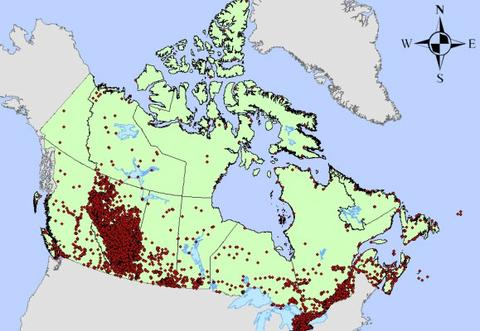Federal clean-up won’t get it all, Need another $40 billion to remove contamination by Suzy Thompson, October 11, 2012, Fast Forward Weekly
On October 3, Environment Minister Peter Kent announced the federal government was launching the second phase of its 15-year plan to clean up nearly 22,000 contaminated sites across the country. Kent admitted at a press conference in Ottawa that, “past practices have had harmful effects on the environment,” and that the government is committed to restoring contaminated areas for the safety of the environment and public. With that announcement, the government pledged $1 billion over the next three years to clean up 1,100 high-priority sites and assess another 1,650. … Environment Canada says this includes “toxic waste sites, abandoned mines, contaminated military installations, leaking fuel storage depots.” The federal government’s definition of a contaminated site is “one at which substances occur at concentrations above background (normally occurring) levels and pose or are likely to pose an immediate or long-term hazard to human health or the environment.”
…
The National Pollutant Release Inventory (NPRI) gathers information from every facility releasing contaminants, such as paper mills, waste treatment plants, hospitals, military bases and oil and gas facilities. According to the NPRI’s data, Alberta accounts for 41 per cent of the country’s polluters, with 3,311 reporting facilities in 2010. Eighty per cent of those Alberta facilities are oil and gas producers. … In 2007, a report commissioned by the Canadian Council of Ministers of the Environment found the total remediation costs of soil and water contaminated by petroleum hydrocarbons (PHCs) alone to be almost $41 billion.
The report found that due to the scale and cost of contamination, “the estimated magnitude of remediation work associated with PHC contaminated sites is projected to exceed the current annual capacity of the remediation industry by more than 57 times…. The largest PHC contaminated site liabilities are in the provinces with large upstream oil and gas industries; those provinces also have relatively small remediation industries.” It concludes that since the cost of restoring polluted land would often be higher than the value of the land itself, “there is no net monetizable benefit to the economy as a whole associated with the remediation of a contaminated site.”
The 2010 soil quality guidelines report, also commissioned by the Canadian Council of Ministers of the Environment, found that despite knowing many PHCs and related chemicals cause cancer, and that there are hundreds of different types of these compounds, little toxicological information exists for most of them. Because of this dearth of knowledge, the environmental and health risks of only nine types of PAHs were examined for the soil quality review.
…
“The system lacks standard closure reporting as well as clear and measurable expectations for what departments with custodial responsibilities for contaminated sites are to accomplish,” writes the auditor general’s commissioner of the environment and sustainable development, Scott Vaughan. “There is no consolidated Government of Canada report showing progress in terms of total sites remediated, which sites remain contaminated, what it will cost to remediate them, and what the potential consequences are of not taking action”
In researching this story, Fast Forward Weekly was passed from one federal department to another as government representatives claimed someone else was responsible for the program. [Emphasis added]
Source: Fast Forward Weekly

